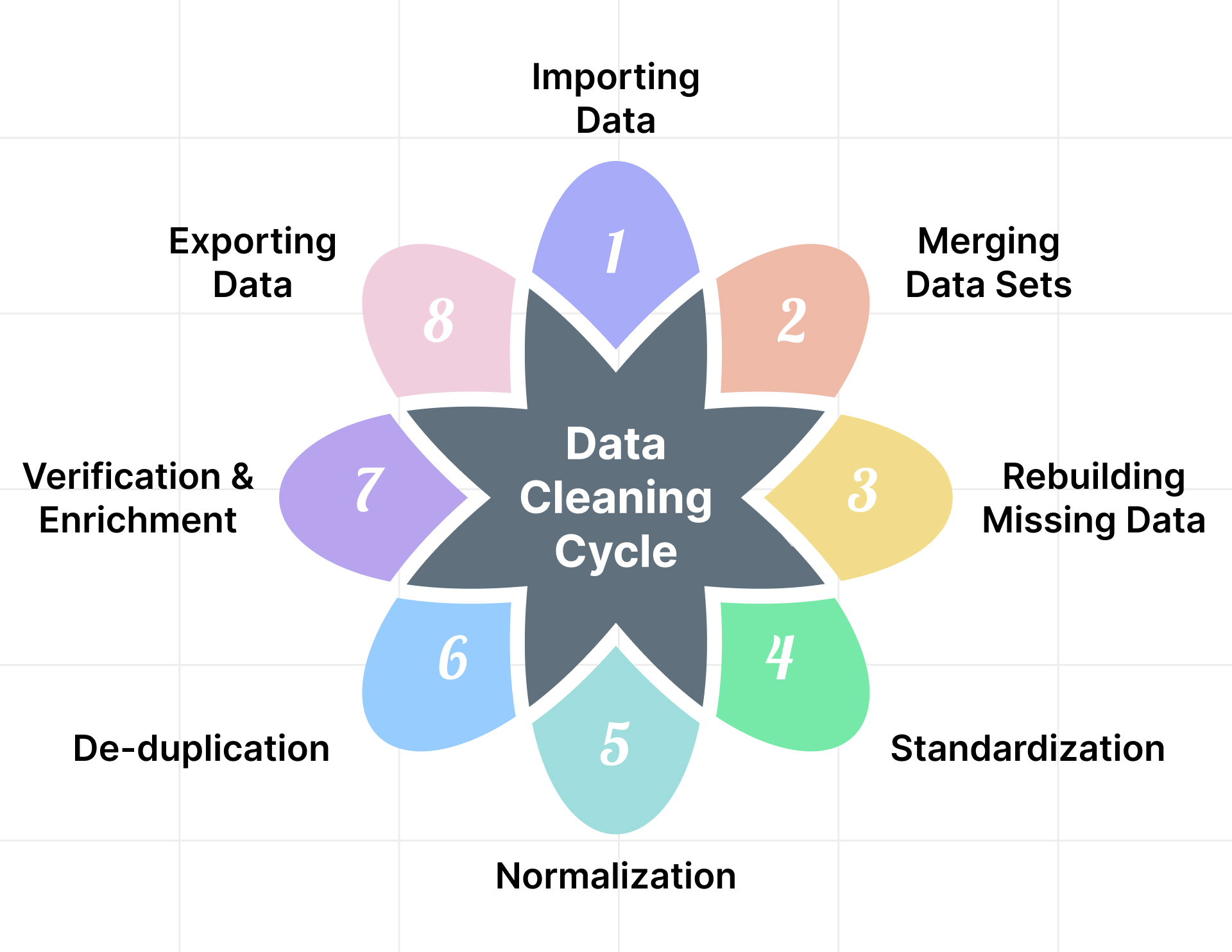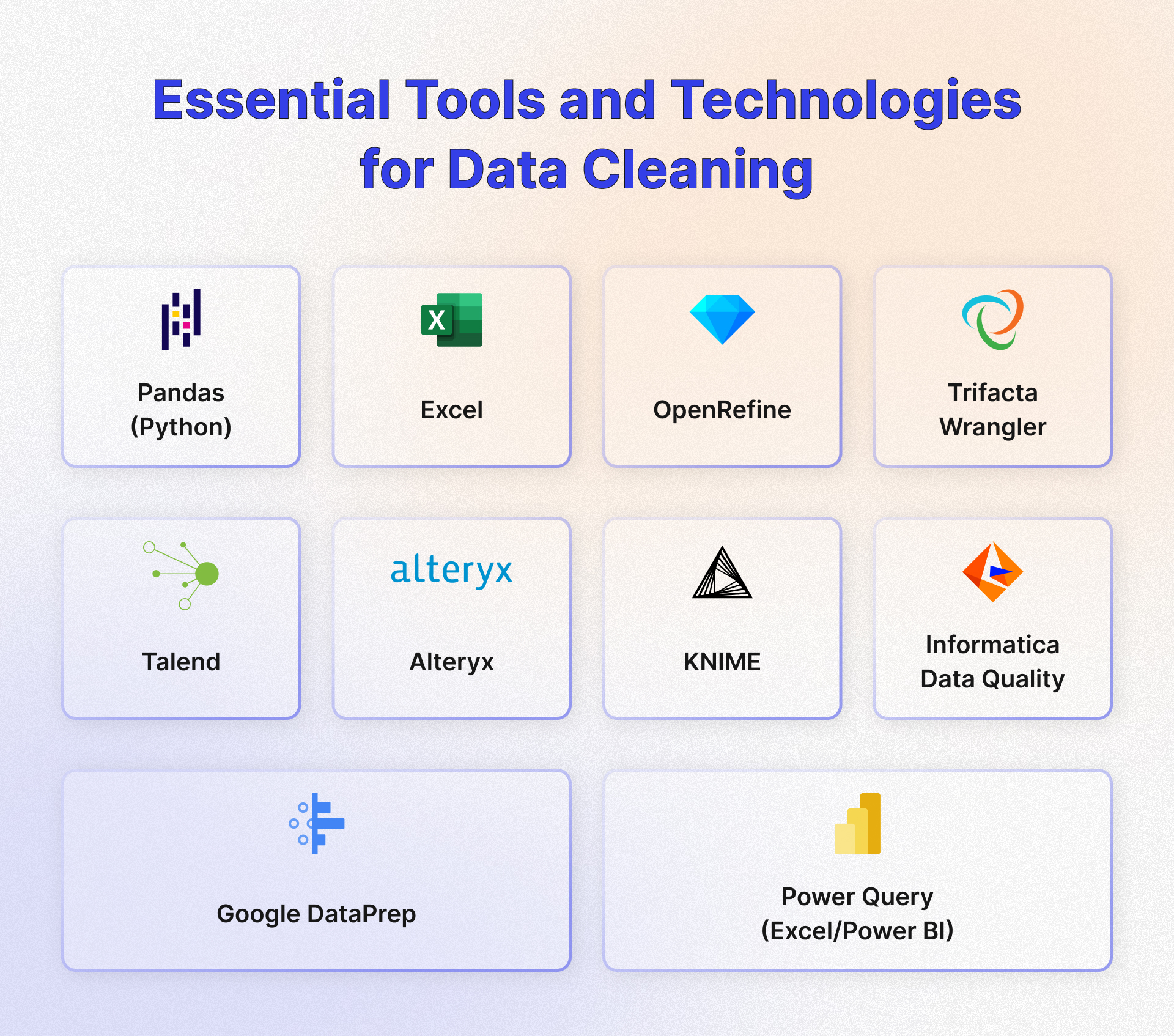In the modern workplace, data is a valuable asset that informs choices, creates strategy, and creates innovation. However, the utility of data is dependent on its quality. Data science, the process of extracting insights from data, strongly relies on clean, accurate data.
Without data cleaning, the insights gained can be deceptive, leading to poor judgments and lost opportunities. This blog examines the critical role of data cleaning in business performance, outlining its importance, strategies used, technologies available, and the issues firms face due to unclean data.
What is Data Cleaning?
Data cleaning, also known as data cleansing or scrubbing, is detecting and correcting (or removing) corrupt, incomplete, inaccurate, or irrelevant records from a dataset. It involves various steps, such as handling missing data, correcting errors, standardizing data formats, and removing duplicates. The goal is to enhance the quality of the data, making it suitable for analysis and decision-making. This process typically includes:
- Detection of Errors: Identifying inaccuracies, inconsistencies, and anomalies in the dataset.
- Correction of Errors: Rectifying identified issues by replacing incorrect data with correct values, standardizing formats, and filling in missing information.
- Removal of Redundant Data: Eliminating duplicate records ensures each entry is unique.
- Validation: Ensuring that the data conforms to defined rules and standards, thus making it suitable for analysis.
Understanding the Data Cleaning Cycle
The data cleaning cycle is a continuous process that ensures the accuracy and quality of data through various stages. Each step in this cycle plays a crucial role in maintaining the integrity of data, which is fundamental for any business relying on data-driven decision-making. Here’s a breakdown of the cycle:
- Importing Data: Data is collected from various sources and is ready to be processed and cleaned.
- Merging Data Sets: Different data sets are combined to form a comprehensive dataset that provides a broader view and is more advantageous for analysis.
- Standardization: Data is standardized into a consistent format, making it easier to work with by aligning disparate data types and units.
- Normalization: This step involves adjusting the data values to fit within a particular range or scale, enhancing the data’s consistency and reliability.
- Rebuilding Missing Data: Missing data entries are identified and imputed or reconstructed to ensure completeness of the dataset.
- Deduplication: Duplicate data entries are identified and removed to prevent redundancy and ensure each data point is unique.
- Verification & Enrichment: Data is verified for accuracy and enriched by adding relevant information to increase its value and usefulness.
- Exporting Data: After cleaning, the data is exported for analysis or further processing and is now ready to deliver insights with greater accuracy.
Essential Tools and Technologies for Data Cleaning
Several tools and technologies can help in data cleaning, ranging from open-source solutions to commercial platforms:
- Pandas (Python): A highly versatile library for data manipulation and analysis in Python.
- Excel: A ubiquitous tool with powerful functions and add-ins for data cleaning and transformation.
- OpenRefine: An open-source tool specialized for data cleaning and transformation.
- Trifacta Wrangler: Provides intuitive interfaces for data wrangling and cleaning.
- Talend: An extensive data integration tool with robust data cleaning features.
- Alteryx: Known for its user-friendly interface and powerful data blending and cleaning capabilities.
- KNIME: Offers a wide array of data cleaning and integration functionalities.
- Informatica Data Quality: A comprehensive profiling, cleaning, and managing data quality tool.
- Google DataPrep: Facilitates data cleaning and preparation with an easy-to-use interface.
- Power Query (Excel/Power BI): Strong data transformation and cleaning features integrated within Microsoft’s ecosystem.
Challenges Businesses Encounter Due to Unclean Data
Poor Decision-Making
Unclean data can lead to incorrect insights, resulting in flawed business strategies and decisions. It can significantly impact business performance, leading to missed opportunities and competitive disadvantages.
Increased Costs
Dealing with data issues during analysis can be time-consuming and resource-intensive, increasing operational costs. These costs can escalate as data quality issues propagate through various business processes.
Customer Dissatisfaction
Incorrect or insufficient data can create negative customer experiences, harming the company’s reputation and customer relationships. Misunderstanding client needs or failing to adequately address their complaints can lead to customer churn.
Compliance Risks
Noncompliance with data quality regulations can result in legal issues and financial penalties, posing significant risks to the business. Ensuring data quality is essential to meet regulatory requirements and avoid these risks.
The Necessity of Data Cleaning for Quality Assurance
Enhancing Data Quality
High-quality data is required for accurate analysis. Data cleaning guarantees that data is correct, complete, and consistent, which is critical for gaining valuable insights. Inaccurate or inconsistent data might result in erroneous conclusions and poor business decisions.
Supporting Decision-Making
Businesses depend on data to make strategic and operational decisions. Clean data provides a solid foundation for these decisions, reducing the risk of errors and enabling more accurate forecasting, planning, and strategy development.
Improving Efficiency
By addressing data issues upfront, data cleaning reduces the time and resources required to manage and resolve these issues during analysis. This results in more efficient data processing operations, allowing analysts to focus on gaining insights rather than resolving data issues.
Ensuring Regulatory Compliance
Many industries are subject to strict data quality standards and regulations. Data cleaning enables firms to comply with these standards, avoiding the legal and financial penalties associated with noncompliance.
Boost Success With Data Science Services Today…!
Does Your Business Require Data Cleaning Practices?
Data cleaning is essential for any business that relies on data for its operations. Here are key reasons why:
- Improved Decision-Making: Clean data results in more accurate and actionable insights, leading to better business decisions and strategies.
- Enhanced Customer Insights: By ensuring customer data quality, businesses can gain a deeper understanding of customer behavior and preferences, improving customer service and enabling targeted marketing efforts.
- Operational Efficiency: Clean data lowers errors in company operations, increasing operational efficiency and productivity.
- Regulatory Compliance: Clean data ensures adherence to data quality standards and regulations, mitigating the risk of legal issues.
Measuring the Success of Data Cleaning Effectively
To measure the success of data cleaning efforts, businesses can use several metrics:
- Data Accuracy: The percentage of correct entries in the dataset. It can be measured by comparing the cleaned data against a known reference or ground truth.
- Data Completeness: The proportion of complete records versus those with missing values. A high completeness rate indicates that the data cleaning has effectively addressed missing data issues.
- Consistency: The degree to which data entries follow the same format and values. Consistency can be measured by checking for uniform data formats and values across the dataset.
- Timeliness: The extent to which data is up-to-date. Timeliness can be assessed by comparing the data’s age to the expected update frequency.
- Uniqueness: The number of duplicate records present in the dataset. A low number of duplicates indicates effective deduplication.
Advantages and Disadvantages of Data Cleaning Practices
There are several advantages of the data cleaning process.
- Enhanced Data Integration: Clean data facilitates smooth integration across various systems and platforms within an organization. This integration enables businesses to consolidate information effectively, leading to a holistic view of operations, customers, and market trends.
- Data Accessibility: Data cleaning ensures that information is readily accessible and understandable for stakeholders across different departments. This accessibility fosters collaboration and empowers teams to make informed decisions based on shared, reliable data.
- Facilitates Scalability: As businesses grow, the volume and complexity of data also increase. Data cleaning prepares datasets for scalable growth by ensuring that new data can be seamlessly integrated and analyzed without compromising quality or performance.
- Data Security: Clean data reduces the risk of security breaches and unauthorized access. By eliminating duplicate or outdated records and ensuring data accuracy, businesses can better protect sensitive information and maintain compliance with data protection regulations.
- Supports Data-driven Innovation: Clean data serves as a foundation for exploring new opportunities and innovations within the business. It allows organizations to confidently experiment with advanced analytics, machine learning algorithms, and predictive models, driving innovation and competitive advantage.
- Resource Allocation: Data cleaning optimizes resource allocation beyond operational efficiency by identifying redundant processes or outdated datasets. This optimization frees up resources that can be redirected toward innovation, customer-centric initiatives, or strategic growth objectives.
- Business Agility: Agility is crucial for responding to changing customer demands and competitive pressures in fast-paced markets. Clean data enables businesses to adapt quickly by providing accurate real-time insights, supporting agile decision-making and proactive strategies.
The Disadvantages are:
- Resource Intensive: Data cleaning can require significant time, effort, and cost, especially for large datasets. It often demands dedicated resources and continuous maintenance.
- Complexity: The data cleaning process can be complex, involving various types of data issues that need to be addressed systematically. This complexity can increase with the volume and variety of data.
- Need for Expertise: Effective data cleaning requires skilled professionals with expertise in data management, which can be a challenge for businesses lacking such resources.
Maximizing Business Potential through Data Cleaning
Data cleaning is a critical component of data science that directly impacts company success. Organizations can make improved choices, enhance customer experiences, and increase operational efficiency if their data is accurate, complete, and dependable. Despite the obstacles and resources involved, the advantages of adequate data cleaning far outweigh the disadvantages. Investment in effective data cleansing technologies and procedures is critical for every firm that wants to succeed in today’s data-driven environment.




